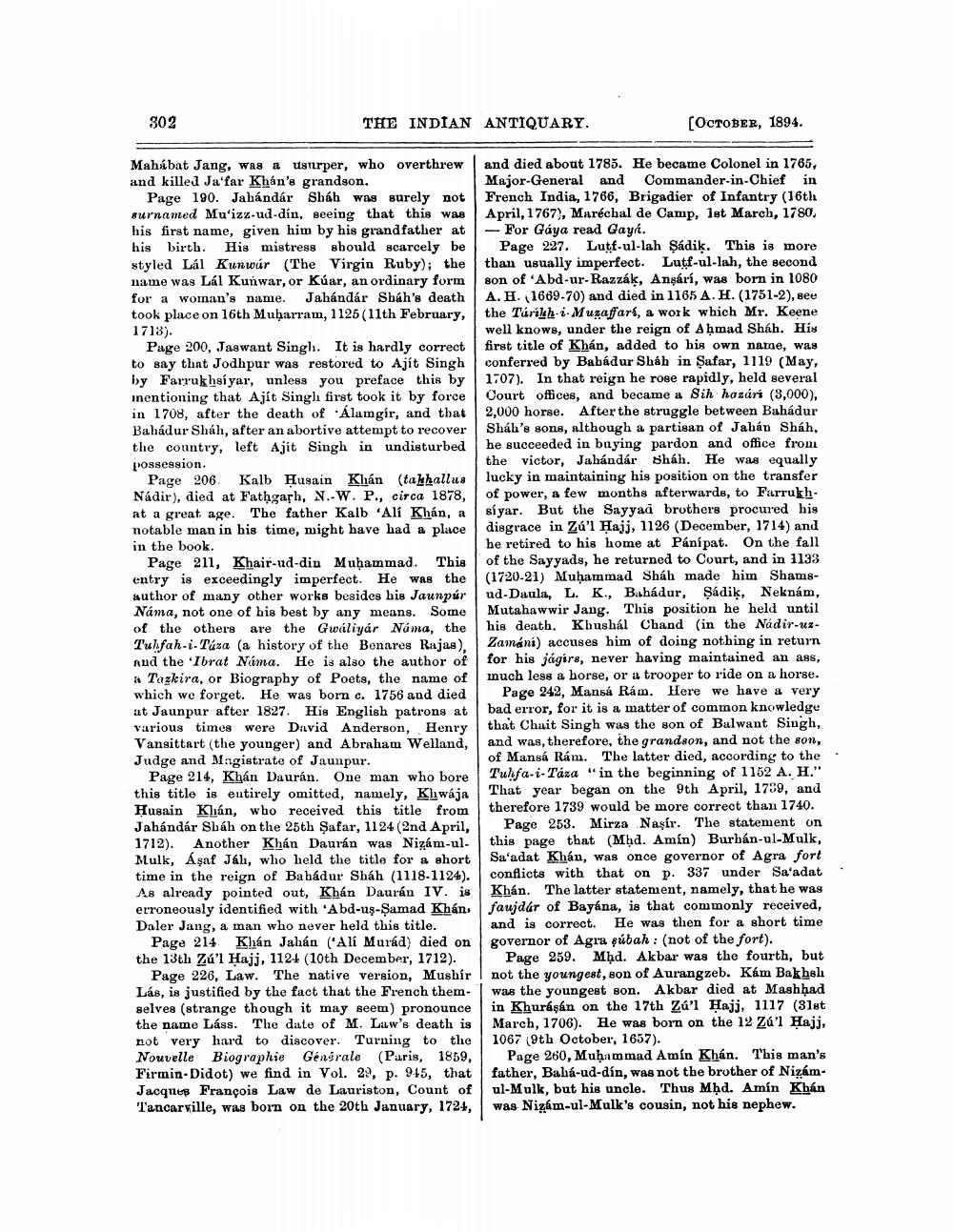________________
302
[OCTOBER, 1894.
1718).
and died about 1785. He became Colonel in 1765, Major-General and Commander-in-Chief in Page 190. Jahándár Sháh was surely not French India, 1766, Brigadier of Infantry (16th surnamed Mu'izz-ud-dín, seeing that this was April, 1767), Maréchal de Camp, 1st March, 1780, his first name, given him by his grandfather at For Gáya read Gayi. his birth. His mistress should scarcely be Page 227. Lutf-ul-lah Sádik. This is more. styled Lál Kunwar (The Virgin Ruby); the than usually imperfect. Lutf-ul-lah, the second name was Lál Kunwar, or Kúar, an ordinary form son of 'Abd-ur-Razzák, Angárí, was born in 1080 for a woman's name. Jahándár Shah's death A. H. 1669-70) and died in 1165 A. H. (1751-2), see took place on 16th Muharram, 1125 (11th February, the Tárikh-i-Muzaffari, a work which Mr. Keene well knows, under the reign of Ahmad Shah. His first title of Khán, added to his own name, was conferred by Babádur Shah in Safar, 1119 (May, 1707). In that reign he rose rapidly, held several Court offices, and became a Sih hazári (3,000), 2,000 horse. After the struggle between Bahadur Shah's sons, although a partisan of Jahan Shah, he succeeded in buying pardon and office from the victor, Jahándár Sháh. He was equally lucky in maintaining his position on the transfer of power, a few months afterwards, to Farrukhsíyar. But the Sayyad brothers procured his disgrace in Zú'l Hajj, 1126 (December, 1714) and he retired to his home at Pání pat. On the fall of the Sayyads, he returned to Court, and in 1133 (1720-21) Muḥammad Sháh made him Shamsud-Daula, L. K., Bahádur, Sadik, Neknám, Mutahawwir Jang. This position he held until his death. Khushál Chand (in the Nádir-uzZamáni) accuses him of doing nothing in return for his jágirs, never having maintained an ass, much less a horse, or a trooper to ride on a horse.
THE INDIAN ANTIQUARY.
Mahabat Jang, was a usurper, who overthrew and killed Ja'far Khán's grandson.
Page 200, Jaswant Singh. It is hardly correct to say that Jodhpur was restored to Ajit Singh by Farrukhsiyar, unless you preface this by inentioning that Ajit Singh first took it by force in 1708, after the death of Alamgir, and that Bahadur Shah, after an abortive attempt to recover the country, left Ajit Singh in undisturbed possession.
Page 206. Kalb Husain Khán (takhallus Nádir), died at Fathgarh, N.-W. P., circa 1878, at a great age. The father Kalb 'Ali Khán, a notable man in his time, might have had a place in the book.
Page 211, Khair-ud-din Muhammad. This entry is exceedingly imperfect. He was the author of many other works besides his Jaunpúr Náma, not one of his best by any means. Some of the others are the Gwáliyár Náma, the Tuhfah-i-Túza (a history of the Benares Rajas), And the 'Ibrat Náma. He is also the author of a Tazkira, or Biography of Poets, the name of which we forget. He was born c. 1756 and died at Jaunpur after 1827. His English patrons at various times were David Anderson, Henry Vansittart (the younger) and Abraham Welland, Judge and Magistrate of Jaunpur.
Page 214, Khán Daurán. One man who bore this title is entirely omitted, namely, Khwaja Husain Khán, who received this title from Jahándár Sháh on the 25th Safar, 1124 (2nd April, 1712). Another Khán Daurán was Nizám-ulMulk, Áşaf Jáh, who held the title for a short time in the reign of Bahadur Sháh (1118-1124). As already pointed out, Khán Daurán IV. is erroneously identified with 'Abd-us-Samad Khán, Daler Jang, a man who never held this title.
Page 214 Khán Jahán (Alí Murád) died on the 13th Zú'l Hajj, 1124 (10th December, 1712).
Page 226, Law. The native version, Mushír Lás, is justified by the fact that the French themselves (strange though it may seem) pronounce the name Láss. The date of M. Law's death is not very hard to discover. Turning to the Nouvelle Biographie Générale (Paris, 1859, Firmin-Didot) we find in Vol. 29, p. 945, that Jacques François Law de Lauriston, Count of Tancarville, was born on the 20th January, 1724,
Page 242, Mansá Rám. Here we have a very bad error, for it is a matter of common knowledge that Chait Singh was the son of Balwant Singh, and was, therefore, the grandson, and not the son, of Mansá Rám. The latter died, according to the Tuhfa-i-Táza "in the beginning of 1152 A. H." That year began on the 9th April, 1739, and therefore 1739 would be more correct than 1740.
Page 253. Mirza Naşír. The statement on this page that (Mhd. Amín) Burhán-ul-Mulk, Sa'adat Khán, was once governor of Agra fort conflicts with that on p. 337 under Sa'adat Khán. The latter statement, namely, that he was faujdár of Bayána, is that commonly received, and is correct. He was then for a short time governor of Agra súbah: (not of the fort).
Page 259. Mhd. Akbar was the fourth, but not the youngest, son of Aurangzeb. Kám Bakhshi was the youngest son. Akbar died at Mashhad in Khurásán on the 17th Zú'l Hajj, 1117 (31st March, 1706). He was born on the 12 Zú'l Hajj, 1067 (9th October, 1657).
Page 260, Muḥammad Amín Khán. This man's father, Bahá-ud-dín, was not the brother of Nizamul-Mulk, but his uncle. Thus Mḥd. Amín Khán was Nizám-ul-Mulk's cousin, not his nephew.




